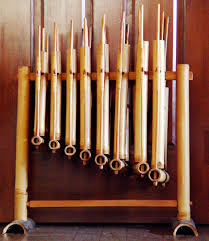.


History
The Angklung got more international attention when Daeng Soetigna, from Bandung, West Java, expanded the angklung notations not only to play traditional pélog or sléndro scales, but also diatonic scale in 1938. Since then, angklung is often played together with other western music instruments in an orchestra. One of the first well-known performances of angklung in an orchestra was during the Bandung Conference in 1955. A few years later, Udjo Ngalagena, a student of Daeng Soetigna, opened his "Saung Angklung" (House of Angklung) in 1966 as centre of its development.
In Hindu period and Padjajaran kingdom era, Sundanese people used the angklung to sign the time for prayer. Later, Padjajaran kingdom use this instrument as corps music in Bubat War (Perang Bubat).
Angklung functioned as building the peoples community spirit. It was still used by the Sundanese until the colonial era (Dutch East Indies, V.O.C). Because of the colonial times, the Dutch East Indies government tried to forbid people playing the angklung instrument.
Because it was forbidden to play angkung during this time, the popularity of the instrument decreased and it came to be played only by children in this era.[citation needed]
Gamelan Angklung
In Bali, an ensemble of angklung is called gamelan angklung (anklung). While the ensemble gets its name from the bamboo shakers, these days most compositions for Gamelan Angklung do not use them. An ensemble of mostly bronze metallophones is used instead.
While the instrumentation of gamelan angklung is similar to gamelan gong kebyar, it has several critical differences. First, the instruments are tuned to a 5-tone slendro scale, though actually most ensembles use a four-tone mode of the five-tone scale (an exception would be five-tone angklung from the north of Bali.) Secondly, whereas many of the instruments in gong kebyar span multiple octaves of its pentatonic scale, gamelan angklung instruments only contain one octave, though some five-tone ensembles have roughly an octave and a half. The instruments are often considerably smaller, and hence more portable when used in cremation rituals. The musicians often play in a procession as the funeral bier is carried from the cemetery to the cremation site, in addition to playing music to accompany the ceremony.
The structure of the music is similar to gong kebyar. Jublag and jegog carry the basic melody, which is elaborated by gangsa, reyong, ceng-ceng, drum, and flute. A medium sized gong, called kempur, is generally used to punctuate a song's major sections. And although most older compositions generally do not employ gong kebyar's more ostentatious virtuosity and showmanship, many Balinese composers have created kebyar-style works for gamelan angklung, often featuring dance.
Outside Indonesia
In the early 20th century, the angklung was adopted in Thailand, where it is called angkalung (อังกะลุง). The Thai angklung are typically tuned in the Thai tuning system of seven equidistant steps per octave, and each angklung has three bamboo tubes tuned in three separate octaves rather than two, as is typical in Indonesia.
Angklung had also been adopted by its Austronesian neighbours, in particular by Malaysia and the Philippines, where they are rather played as part of bamboo xylophone orchestras. Formally introduced into Malaysia sometime after the end of confrontation, it found immediate popularity.[1] They are generally played using a pentatonic scale similar to the Indonesian slendro, although in the Philippines, sets also come in the diatric and minor scales used to perform various Spanish-influenced folk music.
At least one Sundanese angklung buncis ensemble exists in the United States. Angklung Buncis Sukahejo is an ensemble at The Evergreen State College, and includes eighteen double rattles (nine tuned pairs) and four dog-dog drums.


No comments:
Post a Comment